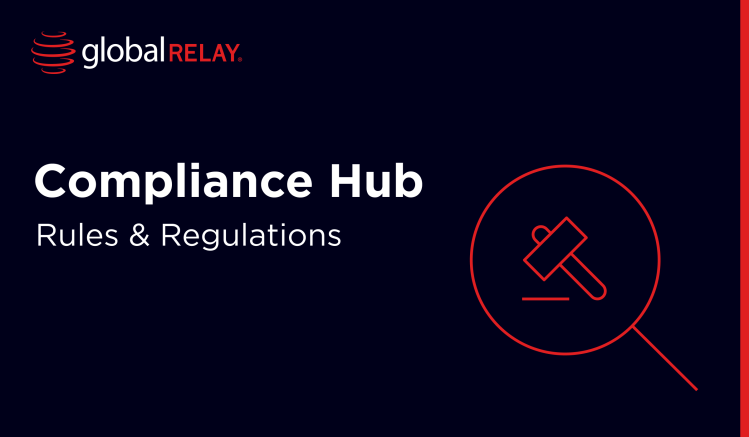
NASD Rule 3010: What is it and what are the requirements?
Did you know that the supervision section of NASD’s rule 3010 is one of the most violated rules in all of the SEC’s regulations? By now, broker-traders know the risks of non-compliance. Alongside monetary fines and suspensions, the reputational effects can cause damage to a firm’s credibility.
Written by a human
In this piece, we’ll be exploring what NASD Rule 3010 entails, and why it was retired and replaced in 2014. Plus, find out why so many firms have struggled to comply, and how to fix your own regulatory woes with Global Relay’s automated communications monitoring.
What is the NASD Rule 3010?
The SEC launched FINRA’s conduct rules in order to standardize the behaviors of all broker-dealers working in the US. The rules aim to build a framework for supervising and inspecting operations, as well as reviewing their procedures and correspondence.
It’s important to note that Rule 3010 is no longer enforced. But you already knew that, didn’t you?
In 2014, the 3010 rule was overwritten and consolidated into 3110. But more on that later, for now, here’s a super quick breakdown of the original NASD rule 3010:
| Section | Details |
| Part A: supervisory systems | Establish and maintain a system to monitor the activities of its members to ensure compliance with relevant laws |
| Part B: written procedures | Develop written communications around supervisory frameworks, including rules around the taped recording of conversations, and disciplinary history |
| Part C: internal inspections | Conduct (at minimum) annual reviews to detect and prevent compliance violations |
| Part D: review of transactions and correspondence | Supervise registered representatives, review their communications, and validate the qualification claims of any job applicant |
So why was it updated?
The primary reason was to make clarifications around the requirements, as the expectations of the regulators severely mismatched those of the companies under compliance.
For example, one of the points of contention was around maintaining a physical presence in special offices. Many companies did not leave these offices manned, even though they had extra responsibility, and could be subject to inspection at any time.
By updating and clarifying the rules, regulators could better manage the expectations of compliant members.
2014 updates superseding the rule (3110)
In 2014, NASD effectively overwrote the 3010 rule with 3110. Fortunately for you, we’ve already written up a full guide to this rule, including its key principles, and an even newer proposal for updates, from 2023.
The rule defines “associated persons” for monitoring, including the likes of branch managers or directors who would be considered the key decision-makers for their companies. It also specifies sole props, government agencies and enterprise employees in the industry.
The main principles of 3110 are:
- Written supervisory procedures (WSPs) – outlining how to supervise, reviewing trades, monitoring external and internal communications and more
- Gaining explicit customer consent for certain financial activities
- Designate and maintain offices for extra responsibility (for inspection)
Common violations: why are broker-dealers struggling so much?
When FINRA released a statement of their top NASD rule violations, many were surprised to see the supervision requirements of rule 3010 in second place. After all, broker-dealers only make up one portion of the regulated financial market, and there were other rules that spanned across more entities.
Let’s take a look at two different rule 3010 case studies to find out more.
Wilson-Davis & Co Case Study
Wilson-Davis & Co was a FINRA member firm that was found guilty of short selling 122 stocks without finding locates (also known as naked short selling). This essentially meant that decision-makers at the firm had been able to effect a sale without seeking approval, to “locate” securities available for borrowing.
Rule 3010 came into play when FINRA found that the two principal supervisory persons (Barkely and Snow) allegedly failed to adequately supervise the short sales to adhere with compliance. Moreover, the leaders also failed to devise a system for supervision, further violating rule 3010.
The firm failed to:
- supervise registered personnel
- consider who’s communications should be supervised
- supervise the communications in question (instant messages)
The violation resulted in a combined fine of over $1 million for the organization, plus individual penalties for Barkely and Snow, including the requirement to requalify.
Thaddeus J North Case Study
In contrast to the above, in the case of Thaddeus J North vs FINRA the blame was concentrated on a single individual.
As CCO, the firm’s WSPs stated that it was Thaddeus who was allegedly responsible for supervising communications and persons at his firm, Southridge. But in the investigated period (July 2009 – September 2011), he admitted to rarely reviewing the emails, and never reviewing communications on the firm’s instant messaging software, Bloomberg, as they were boring.
This failure to adequately supervise electronic communications led to Thaddeus missing the fact that Southridge had entered into a partnership with a previously-disqualified person. And failing to disclose this violation to FINRA led to further troubles. In the end, Thaddeus was fined $40,000, as well as receiving a two-month suspension from his activities.
In the end, Thaddeus was fined $40,000, as well as receiving a two-month suspension from his activities.
Similarities in the violations
FINRA targeted different parties in each of the examples given (one entity, one individual). However, it’s clear that in both cases, it was the failure to adequately supervise that led to the violations.
It makes sense then, that the update of NASD Rule 3010 focused on the written supervisory procedures, as the confusion around these needed to be clarified. However, as firms grow, the number of electronic communications they will need to review will also increase. So it’s about managing those review procedures, ensuring they are regular and thorough, even as broker-dealer firms scale.
Help with compliance
As experts in managing compliance with electronic communications at scale, Global Relay is here to help. We support organizations like Citigo, CapitalOne and even Nasdaq themselves to put compliance at the heart of their business.
Proactively surveil your firm’s electronic communications and identify areas of concern before they become regulatory violations. Our automated monitoring solution enables users to gain a holistic overview of what’s happening in their business, review red flags and prove their compliance with logging and reporting.
Plus, relying on Global Relay means that your supervisory professionals can work efficiently, flexible and reduce false positives. Read our Guidebook, Compliance Solutions for Broker Dealers to find out more.
